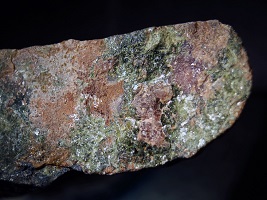
Locality: Turner Mine, Marlow, NH
Specimen Size: 2.5 cm horizontal view
Field Collected: Kevin Czaja
Catalog No.: A Kevin Czaja specimen, "12"
Notes: Massive green candidate dickinsonite. A low count, noisy, EDS analysis suggested dickinsonite is a good candidate, supported by Mn > Fe and possibility that un-quantified peaks are the required Al.
An EDS analysis by Kevin Czaja of this massive green mineral for his Mar/Apr 2025 Rocks & Minerals article on the Turner Mine provided a much improved result. The quantified chemistry from this analysis indicated K1.22Na12.6Ca0.86Fe4.21Mn12.3Al1.4P12O59H2.7 , normalized for 12 P.
Mindat.org (2025) reports dickinsonite-(KMnNa) chemistry as:
(KNa)(Mn2+[ ])Ca(Na3)Mn2+13Al(PO4)11(PO4)(OH)2 .
The Turner Mine sodium content is very high for dickinsonite. A webmineral.com analysis of a dickinsonite has 3.9 APFU of Fe, which is allowed in their formula, but not present in the mindat.org formula.
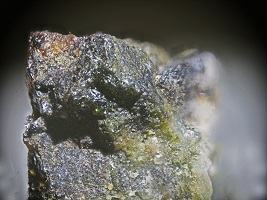
Locality: Turner Mine, Marlow, NH
Specimen Size: 5 mm field of view.
Field Collected: Kevin Czaja ?
Catalog No.: u2787
Notes: [tm] I believe this is a small sample from a Kevin Czaja specimen. The dickinsonite is the dark glassy green area on the upper portion of the sample. Really not much to see here.
EDS analyses, BC575, computed a chemistry of:
K1.02Na3.34Ca0.92Fe10.04Mn15.34Al0.64P7.23O48 normalized for 48 O.
Ideal dickinsonite chemistry (mindat.org) is:
(KNa)(Mn2+[ ])Ca(Na3)Mn2+13Al(PO4)11(PO4)(OH)2 .
For this Turner dickinsonite, all the expected elements are present, but the Mn+Fe is high.
Dickinsonite is a very elusive NH species. Most candidates analyze to be another member of the arrojadite group.
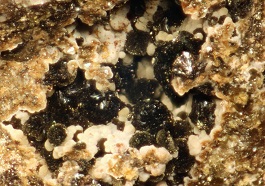
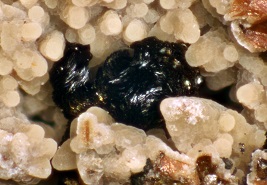

Confidence: 3
Chemistry: &n; Chandler Mill Mine, Newport, NH
Specimen Size: 4 mm field of view - top photo
Field Collected: Bob Wilken
Owner: Bob Wilken
bsp; Ca0.5Fe2+Fe3+5(PO4)4(OH)6 · 2H2O
Locality: Analysis: EDS analysis. This analysis implies a chemistry (normalized for 4 P) of: Ca2.9Fe3.4P4O17.8. This is very heavy on the calcium for dufrenite, but with no other elements showing up, dufrenite is a "best fit."
Notes:
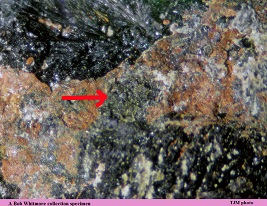
Confidence: 2 (no supporting analysis)
Chemistry: Ca0.5Fe2+Fe3+5(PO4)4(OH)6 · 2H2O
Locality: Fletcher Mine, N. Groton, NH
Specimen Size: 1.5 mm zone @ red arrow of gray-green dufrenite.
Field Collected: Bob Whitmore - 1968. Specimen likely sold.
Catalog No.: A Bob Whitmore specimen
Analysis: None
Notes: Basically an iron phosphate with a pinch of calcium. Could be difficult to differentiate from rockbridgeite chemically and visually.
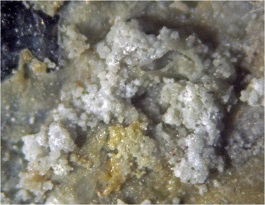
Confidence: 4
Chemistry: Fe3+3(AsO4)2(OH)3 · 5H2O
Locality: Parker Mtn. Mine, Center Strafford, NH
Specimen Size: 4 mm field of view
Field Collected - owner: Tom Mortimer - 1995
Catalog No.: 1900
Analysis: Ferrisymplesite indicated by EDS analysis of this white crust. An EDS analysis of the white blades on the same specimen with the ferrisymplesite crust also indicate ferrisymplesite.
Notes: White ferrisymplesite crust on green-yellow scorodite on lollingite substrate. Arsenolite, As2O3 was reported from Parker Mtn. by Phillip Foster in 1966. It is also a white crusty mineral, but contains no iron. Scorodite, another iron-arsenic crusty mineral, Fe3+AsO4·2H2O has equal parts Fe and As, where-as this analysis indicates a mineral with Fe > As. It is unknown what level of testing was done by/for Foster to arrive at his arsenolite identification.
Given the possibility of other iron-arsenic species, additional testing will increase confidence.
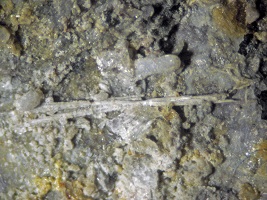
Locality: Parker Mtn. Mine, Center Strafford, NH
Specimen Size: 6 mm prism blade group
Field Collected: Tom Mortimer - 1995
Catalog No.: 1900
Notes:
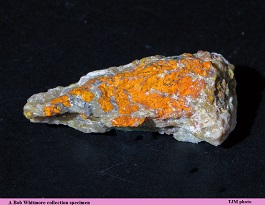
Locality: Ruggles Mine, Grafton, NH
Specimen Size: 3.2 cm specimen
Field Collected: John Reiner?
Catalog No.: A Bob Whitmore specimen ex. John Reiner #4448. Likely sold by Bob. A 2015 photo.
Notes: Fourmarierite has appeared on a number of earlier New Hampshire mineral species lists. However, per Frondel, C., 1956, Mineral Composition of Gummite, Am Min. V. 41 539-568: "Fourmarierite was doubtfully identified as a minor constituent of gummite from a number of localities, including .... the Palermo and Ruggles pegmatites in New Hampshire."
A more recent article by Korzeb, Foord, and Lichte, The center evolution and paragenesis of uranium minerals from the Ruggles and Palermo granitic pegmatites, New Hampshire, Canadian Mineralogist, Vol. 35, pp. 135-144 (1997), expands on Frondel's paper and does not mention formarierite in the paragenesis of uranimum minerals at the subject localities.
This ex. John Reiner specimen is likely typical of historical NH specimens labeled as fourmarierite. Its appearance matches Mineral 'A' described in the Korzeb et. al. article: as "the common component of orange gummite", composition: (UO2)(OH)4 · 1/2H2O + 2H+(aq)
Mindat.org gives the formula for formarierite as Pb(UO2)4O3(OH)4 · 4H2O
Finally, I (TM) would like to note how difficult it is to eliminate discredited species occurrences once they have appeared in the literature. Art Smith's article, New Hampshire Mineral Locality Index, included in Vol. 80 pp. 242-261 (2005), Rocks and Minerals, lists formarierite as occurring at the Ruggles Mine.
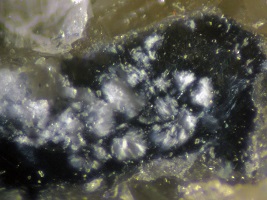
Confidence: 2
Chemistry: CaAl2(PO4)2(OH)2 · H2O
Locality: Palermo Mine, N. Groton, NH
Specimen Size: 2 mm field of view. White sprays embedded in vivianite.
Field Collected: Unknown. Found in a box of "Palermo rough" material
Owner: Arnaldo Brunetti - Canada
Analysis: The specimen was labeled gatumbaite. An EDS analysis (BC160 - 3/2/17) of one of these white balls (on carbon tape) gave a result for which gatumbaite may be a "best fit" with some Sr and K substituting for some Ca. The analysis suggests a chemistry (normalized for 2 P): Ca0.35K0.07Sr0.17Al3.21(PO4)2(O)11
Notes: Arnaldo sent me this specimen for analysis.
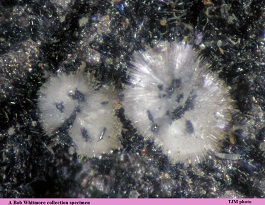
Locality: Palermo Mine, N. Groton, NH
Specimen Size: 2 mm field of view. Gatumbaite on bed of vivianite crystals.
Field Collected: G. Bjareby
Owner: A Bob Whitmore specimen - since sold
Notes: Specimen label reads: "GATUMBAITE - Found by G. Bjareby in 1948." Gatumbaite is not listed in Whitmore & Lawrence's The Pegmatite Mines Known as Palermo.
Unfortunately, I [TM] never had an opportunity to test this.
In a conversation with Bob Whitmore, he said he regretted this species was not first described from Palermo, but delays getting the analysis done allowed the type locality and name escape from Palermo.

Locality: Palermo Mine, N. Groton, NH
Specimen Size: 7 mm field of view. Radial sprays of gatumbaite on bed of vivianite crystals.
Field Collected: G. Bjareby
Owner: A Bob Whitmore specimen - since sold
Notes: Another view of the Bjareby gatumbaite specimen. The inner area of the leftmost spray (particularly) appears zoned dark-blue suggesting perhaps a different mineral? The mineral base for the specimen is un-altered triphylite. The triphyllite surface is covered with very small vivianite crystals. The gatumbaite is on top of these micro-vivianites.
From American Mineralogist, vol. 69 pg. 382: "Sinkankasite has been found at the Palermo Mine, in North Groton, New Hampshire, on only one specimen. It occurs as flattened, circular, 2-3 mm sprays of white acicular crystals associated with vivianite in a fracture in massive triphylite. This material was previously described as gatumbaite by Segeler et al. (1981)."
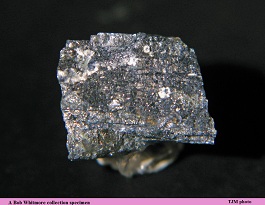
Locality: Palermo Mine, N. Groton, NH
Specimen Size: 1.7 cm specimen. Gatumbiate on vivianite on triphylite
Field Collected: G. Bjareby
Owner: A Bob Whitmore specimen - since sold
Notes: Full specimen view of the Bjareby gatumbaite specimen.
Chemistry wise, gatumbaite is close to other calcium-aluminum phosphates also found at Palermo, foggite and crandalite:
Gatumbaite: CaAl2(PO4)2(OH)2 · H2O
Foggite: CaAl(PO4)(OH)2 · H2O
Crandallite: CaAl3(PO4)2(OH,H2O)6
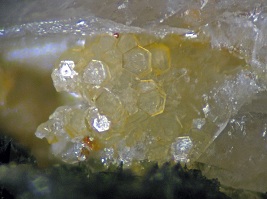
Confidence: 5
Chemistry: BaAl3(PO4)2(OH)5 · H2O
Locality: Plume Mine, N. Groton, NH
Specimen Size: 1.3 mm field of view
Field Collected: Bob Wilken
Owner: Tom Mortimer
Catalog No.: u1052
Analysis: An EDS analysis of these small crystals indicated gorceixite was the best match.
Notes: Forrest-green bjarebyite crystals are adjacent to these gorceixite crystals.
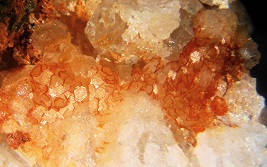
Locality: Plume Mine, N. Groton, NH
Specimen Size: 6.0 mm fov Gorceixite xls with iron oxide coating.
Field Collected: Bob Wilken
Catalog No.: A Bob Wilken specimen and photo
Notes: This gorceixite was generally closely associated with deteriorating Bjarebyite.
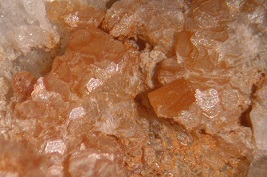
Locality: Plume Mine, N. Groton, NH
Specimen Size: Missing measurement and specimen! A single hexagonal perched on tabular Gorceixite
Field Collected: Bob Wilken
Catalog No.: A Bob Wilken specimen and photo
Notes:
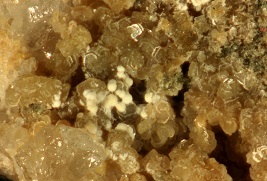
Locality: Plume Mine, N. Groton, NH
Specimen Size: 6.0 mm fov Gorceixite. xl mass
Field Collected: Bob Wilken
Catalog No.: A Bob Wilken specimen and photo
Notes:
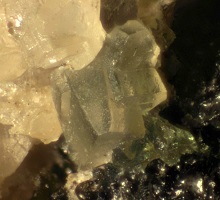
Locality: Plume Mine, N. Groton, NH
Specimen Size: 1.0 mm Gorceixite xl group w. Bjarebyite mass below. A cluster of several interpenetrating xls
Field Collected: Bob Wilken
Catalog No.: A Bob Wilken specimen and photo
Notes:
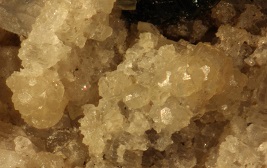
Locality: Plume Mine, N. Groton, NH
Specimen Size: 5.7 mm fov Gorceixite xl masses.
Field Collected: Bob Wilken
Catalog No.: A Bob Wilken specimen and photo
Notes:

Locality: Plume Mine, N. Groton, NH
Specimen Size: 2.7 mm Gorceixite xl grouping. Muscovite xl top center-left.
Field Collected: Bob Wilken
Catalog No.: A Bob Wilken specimen and photo
Notes:
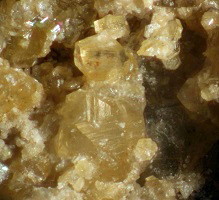
Locality: Plume Mine, N. Groton, NH
Specimen Size: 0.8 mm Two intergrown Gorceixite xls bottom center. Top most transparent to transluscent.
Field Collected: Bob Wilken
Catalog No.: A Bob Wilken specimen and photo
Notes:
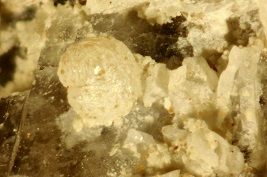
Locality: Plume Mine, N. Groton, NH
Specimen Size: 3.0 mm fov. Gorceixite ball.
Field Collected: Bob Wilken
Catalog No.: A Bob Wilken specimen and photo
Notes:
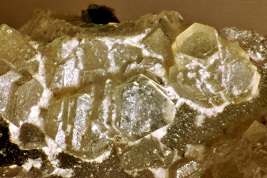
Locality: Plume Mine, N. Groton, NH
Specimen Size: 2.4 mm fov of Gorceixite xls.
Field Collected: Bob Wilken
Catalog No.: A Bob Wilken specimen and photo
Notes:
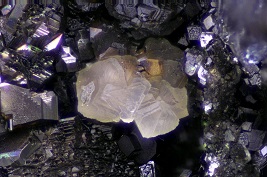
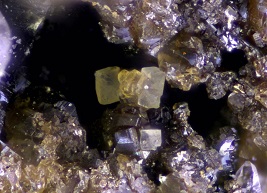
Locality: Chandlers Mill Mine, Newport, NH
Specimen Size: 0.7 mm crystal group, top photo
Field Collected: Bob Wilken
Catalog No.: A Bob Wilken specimen and photo
Notes: Gorceixite indicated by EDS analyses. The chemistry from this analysis is: Ba0.32Al2.91P2.0O7.13 , normalized for 2 P. There are only two Ba, Al, P minerals. The P, Al ratio is close for gorcexite, but the Ba is low.
The Chandlers Mill Mine is the second locality that Bob Wilken has found gorceixite.
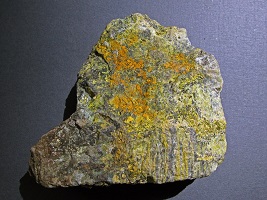
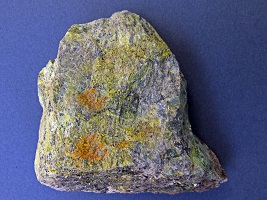
Locality: Ruggles Mine, Grafton, NH
Specimen Size: 11 cm specimen, front & back
Field Collected: Tom Mortimer - Aug. 2020
Catalog No.: NC
Notes: "Gummite", (the orange and yellow here) is not a mineral species, but a mixture of uraninite and secondary uranium minerals of variable composition. It is generally considered a mixture of boltwoodite, clarkeite, curite, kasolite, soddyite, uraninite, and uranophane.
Daylight photos.
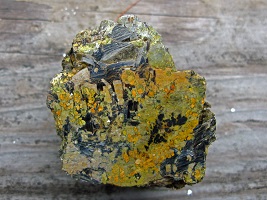
Locality: Ruggles Mine, Grafton, NH
Specimen Size: 6 cm polished surface gummite specimen
Field Collected: Bob Whitmore & Harvard research associates
Catalog No.: NC
Notes: Orange gummite with black uraninite. Specimen very "hot." Left outside and took daylight photo.